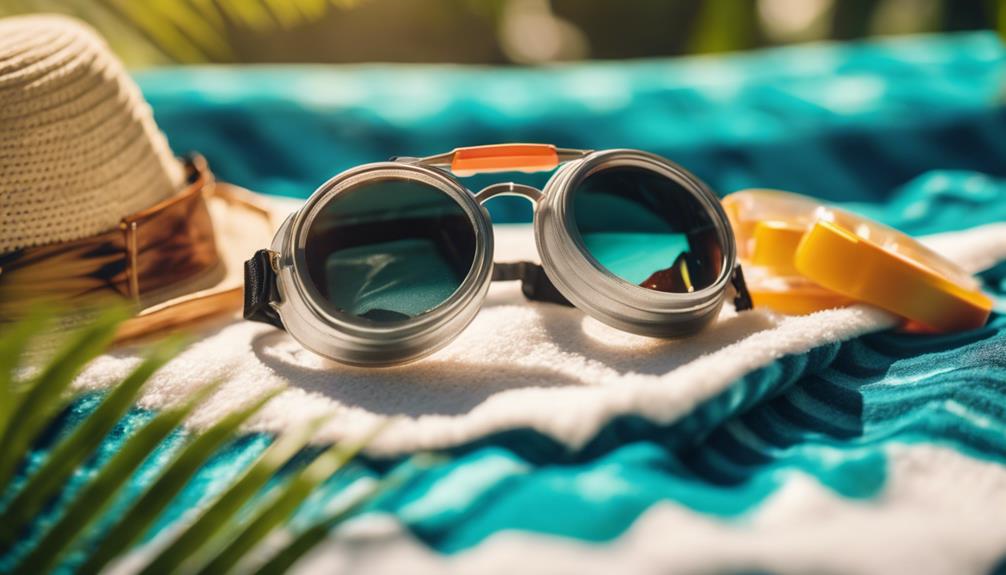When you jump into a tanning bed, you've gotta keep it clean to avoid some serious skin faux pas! First off, always check if the bed's been sanitized—nobody wants to catch a funky skin issue. Bring your own towels or disposable sheets for extra peace of mind, and don't forget your FDA-approved goggles to protect those peepers. Using antimicrobial lotions can help fight off any sneaky germs too! Remember, a clean bed is a happy bed, so ask salon staff about their hygiene practices. Want to rock that golden glow? Stick around for more tips on staying safe and stylish!
Key Takeaways
- Always check that tanning beds are properly sanitized with disinfectant sprays before each use to minimize bacteria exposure.
- Use FDA-approved goggles specifically designed for tanning beds to protect your eyes from harmful UV rays.
- Bring personal disposable sheets or towels to enhance hygiene and comfort during your tanning session.
- Inquire about the salon's cleaning protocols to ensure they follow effective sanitization practices.
Importance of Cleanliness
When you choose a tanning salon, cleanliness is essential to guarantee your safety and minimize the risk of skin infections. You wouldn't want to lie down on a tanning bed that looks like it's never seen a disinfectant, right? So, check for those shiny, clean surfaces and make sure the staff knows their sanitizing game!
After all, nobody wants to deal with unexpected skin issues after a tanning session. Ask about their cleaning practices—if they can't give you a straight answer, it's a red flag!
Essential Protective Measures

To guarantee your safety during tanning sessions, it's crucial to use protective measures like eyewear and disposable sheets that create a hygienic barrier between your skin and the tanning bed.
Seriously, nobody wants to lay on a germy bed, right?
First off, grab those FDA-approved goggles—your eyes will thank you! They're designed to block harmful UV rays, unlike your favorite pair of shades.
Next, use disposable sheets or towels to keep it clean and comfy. You can even bring your own little towel for extra peace of mind.
And hey, don't forget about those disposable undergarments—they're a game-changer!
Choosing Antimicrobial Products

Selecting the right antimicrobial products can enhance your tanning experience while ensuring your skin stays protected from germs. You want to keep your skin healthy, right? So, let's look at some awesome options!
| Product Type | Key Ingredient | Benefits |
|---|---|---|
| Antimicrobial Lotion | Tea Tree Oil | Fights germs and soothes skin |
| Disinfectant Spray | Benzalkonium Chloride | Kills bacteria on surfaces |
| Skin Cleanser | Aloe Vera | Cleans and hydrates before tanning |
Before tanning, make sure your skin's clean and dry. Remember, these lotions aren't magic—combine them with good hygiene practices for the best results. You want that golden glow, not a case of the ickies!
Proper Eye Protection

Proper eye protection is essential for safeguarding your vision while using tanning beds, as regular sunglasses just won't cut it against harmful UV rays.
Trust me, you don't want to end up squinting for the rest of your life! Get yourself some proper eye gear, and here's what to look for:
- FDA-approved goggles: They're specifically designed for tanning beds, so they block those pesky rays effectively.
- Snug fit: Make sure they fit snugly; you want full coverage, not a goggle gap!
Understanding Health Risks

While protecting your eyes is essential, it's just as important to understand the health risks associated with tanning beds, as improper use can lead to serious skin and health issues.
Did you know that these beds can harbor bacteria if not cleaned properly? Yikes! That means you could be tanning and picking up germs at the same time.
Plus, overdoing it can increase your risk of skin cancer. Nobody wants a sunburn, even if it comes from a bed!
So, keep an eye out for clean facilities and limit your sessions. Remember, a golden glow should never come at the cost of your health.
Stay informed, stay safe, and your skin will thank you later!
Best Practices for Hygiene

Maintaining a tanning salon's cleanliness is essential for your health, so always choose facilities that prioritize rigorous hygiene practices. You wouldn't want to lie down on a bed that looks like it hasn't seen a wipe in ages, right?
Here are some best practices to keep in mind:
- Always check if the tanning beds are wiped down and sanitized before your session.
- Bring your own disposable sheets or towels to create a personal barrier.
Additional Resources for Safety

Exploring additional resources can enhance your understanding of tanning bed safety and hygiene practices. You definitely want to stay informed, right? Check out these handy resources that can help you keep your tanning sessions safe and clean:
| Resource Title | Description | Date Published |
|---|---|---|
| Best Tips for Cleaning Salon Tanning Beds | Learn how to guarantee beds are squeaky clean! | May 26, 2024 |
| Top Hygiene Hacks for a Flawless Tanning Session | Quick tricks for a safe tanning experience | May 16, 2024 |
| Get Bronzed Not Bugged: Tanning Bed Cleanliness | Discover the importance of cleanliness | January 25, 2024 |
With these resources, you can arm yourself with the knowledge to make your tanning experience as safe as possible. Happy tanning!
Frequently Asked Questions
How Often Should Tanning Beds Be Disinfected Between Clients?
Tanning beds should be disinfected after every client to minimize infection risks. It's essential you choose salons that prioritize cleanliness and regularly sanitize their equipment to guarantee a safer tanning experience for yourself.
What Should I Do if I Experience Skin Irritation After Tanning?
It's easy to dismiss skin irritation as temporary, but if you experience it after tanning, cleanse the area gently, apply soothing lotion, and avoid further UV exposure. Consult a dermatologist if irritation persists.
Can I Use My Regular Lotion Before Tanning?
You can use your regular lotion before tanning, but it's best to choose an antimicrobial lotion. Make certain your skin is clean and dry for ideal results, and prioritize skin health over achieving a quick tan.
Are There Specific Brands of Goggles Recommended for Tanning?
Imagine diving into a pool without checking for cleanliness; you wouldn't do that, right? For tanning goggles, brands like EyeCandy and Solar Eye provide excellent UV protection, keeping your eyes safe while you enjoy that tan.
How Can I Identify a Reputable Tanning Salon?
To identify a reputable tanning salon, check for cleanliness, ask about their disinfection practices, and look for positive reviews. Inspect the equipment and make certain staff follows proper hygiene protocols for your safety.
Conclusion
So, there you have it! Keeping your skin safe while tanning doesn't have to be a chore.
By sticking to these hygiene tips, you can enjoy that sun-kissed glow without worrying about unwanted skin drama.
Remember, who wants to trade their golden tan for a pesky rash?
With a little care and the right products, you can shine bright like a diamond—without the skin scare!
So, go ahead and glow, just keep it clean!









